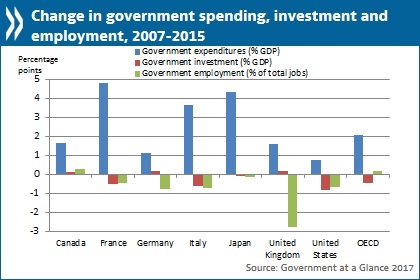Governments should address fall in public investment as costs stabilise
Governments have responded differently to new demands on them since the global crisis, with many raising spending on social services, some trimming public sector employment and most stabilising day-to-day running costs at a lower level. Countries should now seek to correct the steady decline in public investment since 2009, according to a new OECD report.

Government at a Glance 2017 finds that government spending averaged 40.9% of GDP in OECD countries in 2015, up from 38.8% in 2007, before the crisis. The number of government jobs as a share of total employment remained little changed at 18.1% in 2015 versus 17.9% in 2007, although some countries have reported workforce reductions.
While ageing populations and high unemployment drove up social costs to 41% of overall spending in 2015 from 37% in 2007, governments used cost cuts and better efficiency to trim running costs to 37% of spending from 39%. Meanwhile, despite low interest rates, public investment has declined from a 2009 peak of 9.3% of spending to 7.7% in 2015.
Government spending as a share of GDP is highest in France (56.5% in 2016) followed by Finland (56.1%) and Denmark (53.6%). Spending was lowest in 2015 (latest data available) in Mexico (24.5%), Ireland (29.5%) and Korea (32.4%).
The fifth edition of the OECD’s biennial comparison of public sector performance in major economies, finds the biggest share of public investment (a third) goes into economic areas like transportation and energy. The next biggest share (15%) goes on defence. Restoring public investment in areas like infrastructure, technology, green energy and education should have a positive impact on future employment and healthcare, it says.
Working to further improve efficiency and productivity, including through the use of spending reviews, performance evaluation and behavioural insights, and focusing on key areas like public procurement in the health sector could generate more savings that could be channelled into much-needed public investment.
2016 survey data in the report on pay in central government shows a tendency to reward managerial responsibility over technical specialisation. On average, top-level managers earn 27% more than senior managers, 72% more than middle managers, 2.6 times more than senior professionals and four times more than support staff. Adjusted for GDP per capita to account for differences in economic development, top-ranking and middle managers earn the most in Mexico and Colombia and the least in Iceland and Norway. The pay difference between top and middle managers is the highest in Australia, Chile, Canada and the UK.
The report also looks at the pay of public agents like police, immigration officers and tax inspectors. It finds that police officers on central government payroll earn an average of USD 64,795 (at purchasing power parity) while police inspectors earn USD 81,952. Adjusted for differences in GDP per capita, police officers earn the most in Greece, Spain and Portugal.
Other key findings include:
•Denmark, Norway and Sweden have the highest levels of government employment, at nearly 30% of total employment. Asian countries rely less on public sector staff with government jobs making up only 6% of employment in Japan and 7.6% in Korea.
•The most decentralised OECD countries are Switzerland, with over 90% of government staff working at the sub-central level, then Canada and Japan. The most centralised are Turkey and Ireland with around 90% employed at the central level of government.
•Central government revenues in the OECD area were 72.5% financed by taxes in 2015 (from 47.6% in Norway to 91% in Belgium), 16.1% by social contributions (the highest being the US at 33.7%), and the rest by asset sales, grants and other revenues.
•The use of spending reviews has jumped since the crisis, with 23 OECD countries using them in 2016 versus 16 in 2011. Ten countries (Canada, Greece, Ireland, Italy, Latvia, Luxembourg, Sweden, Switzerland, Mexico and the UK) say spending reviews helped them meet 90% or more of their fiscal objectives but nine could not assess their success.
•The share of OECD citizens voicing confidence in their governments fell to 42% in 2016 from 45% in 2007 (2016 Gallup World Poll.) The greatest loss of trust is in Chile, Finland, Greece and Slovenia. Over two-thirds of OECD citizens are satisfied with their healthcare and education systems, but only 55% trust the judicial system and courts.
•Women make up 53% of judges in OECD countries but only 29% of parliamentarians and 28% of ministers. Canada, France, Slovenia and Sweden have gender parity in cabinet posts as of 2017, but women hold only one post in Turkey and zero in Hungary.
•The use of digital government services has tripled in OECD countries since 2006, with around 36% of OECD citizens submitting forms via public authorities’ websites in 2016.
Source: Organisation for Economic Co-operation and Development
- 326 reads
Human Rights
Fostering a More Humane World: The 28th Eurasian Economic Summi

Conscience, Hope, and Action: Keys to Global Peace and Sustainability

Ringing FOWPAL’s Peace Bell for the World:Nobel Peace Prize Laureates’ Visions and Actions

Protecting the World’s Cultural Diversity for a Sustainable Future

Puppet Show I International Friendship Day 2020

